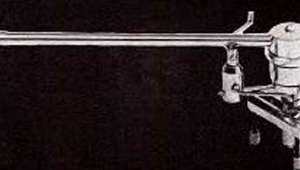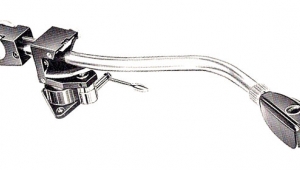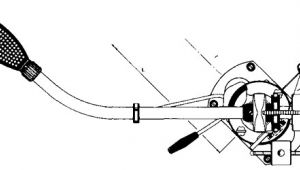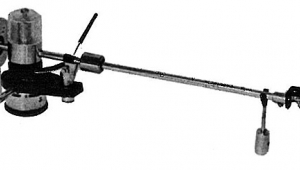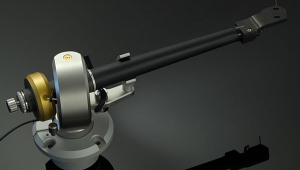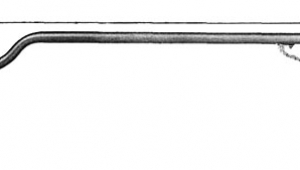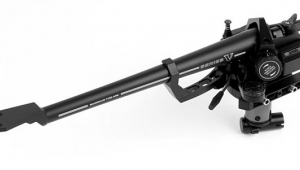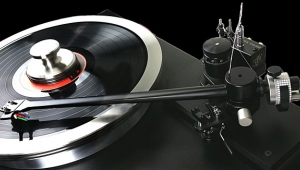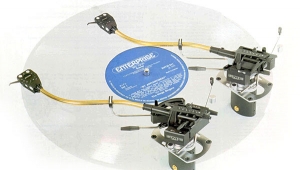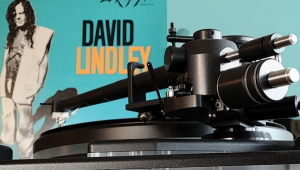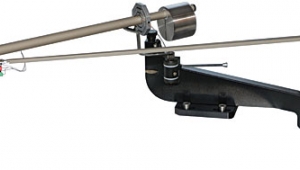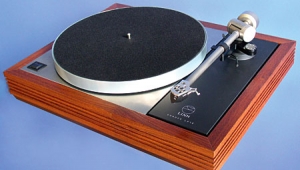| Columns Retired Columns & Blogs |
Linn Ekos SE tonearm, Keel LP12 subchassis, & Trampolin turntable base Page 3
Most telling of all was its performance with real music. Herbert von Karajan's really brilliant 1962 recording of Beethoven's Symphony 5 (Deutsche Grammophon 138 804) was cleaner, more dramatic, and more enjoyable than ever before. The great C-major theme of the final movement was clear as a bell, right down to the timpani that ushered it in: Slightly grainy though that recording is, overall, there was no coarsening of the sound in that or any other passage. Likewise, the fortissimo chords in Witold Malcuzynski's performance of Chopin's Polonaise in A-flat Major, Op.53 (Angel S35728), remained clean, and the really loud solo trombone in the final movement of Hovhaness's Symphony 4 for Winds, in a performance by the Eastman Wind Ensemble (Mercury Living Presence SR90366), startled me by virtue of its musical effect—not by any distortion of its attack.
Footnote 4: Arguably, this is most critical when using a unipivot tonearm such as the Naim Aro—which I've owned and used since 1993.
Also compared with the original Linn Ekos tonearm, the sound of the Ekos SE was noticeably less forward—a bit more subdued, even—yet with louder passages leaping forward from the mix with a greater degree of force. Critics have observed that the original Ekos at times sounded more mechanical than the Naim Aro; while I still hear more of a natural sense of flow from the latter, the new Scottish arm has narrowed the gap—and gone noticeably further than the Naim in retrieving musical detail without the penalty of added brightness. Lyrics were more intelligible with the Ekos SE than with the Ekos or Aro, as on Fairport Convention's version of "Sir Patrick Spens," from the live album House Full (Hannibal HNBL 1319). The fact is, I'd never before realized how funny this song was meant to be...

Two more observations: I think the Ekos SE did a better job with spatial information than its predecessor, with sonic images seeming more solid and real (or unreal, really), and solo instruments and voices standing prouder of the mix—as with the various exotic sounds on "A Very Cellular Song," from the Carthage reissue of the Incredible String Band's The Hangman's Beautiful Daughter (Carthage CGLP 4421—thanks, Wes). And although this has become as much of a cop-out by audio reviewers as the wearing of the flag by politicians, I'm nevertheless convinced that the Ekos SE had stronger, tighter bass than the Aro or Ekos. The only drawback—heard more than once in the past few weeks, for whatever reason—was that low-frequency noises, such as the foot-banging in Martha Argerich and Mstislav Rostropovich's recording of Chopin's Cello Sonata in G Minor, Op.65 (Deutsche Grammophon 2531 201), and the 60Hz hum and brink-of-feedback dreadnought boom throughout the first disc of Crosby, Stills, Nash & Young's 4 Way Street (Atlantic SD 2-902), were also stronger, and thus more intrusive. Seriously.
Keel: When I first set ears on the LP12 with the Keel in place of my original steel subchassis, laminate tonearm board, and standard Ekos mounting collar, I was surprised: Even with the cheap-and-cheerful Linn Adikt cartridge in the headshell of the Ekos SE, the sound was both bigger and richer than I'd expected.
Which raises an interesting question: What exactly had I expected? Increased detail, for one thing. But I can't deny that I also expected detail's handmaiden, thinness, to come along for the ride, whether I wanted her or not. And who could blame me? Most recent LP12 refinements—especially the Cirkus bearing and subchassis upgrade—have taken the sound of the Linn further and further from the richness and warmth I came to love years ago, musical improvements notwithstanding.
But the opening bars of Clifford Curzon's 1962 recording of Brahms' Piano Concerto 1, with George Szell and the London Symphony (Decca/Speakers Corner SXL 6023), sounded shockingly, engagingly full: There was more acoustic space than before, without a doubt—but there was also more music in that space. In fact, the rosiny texture of the violins and the purr of the Steinway grand had been turned up a notch, to my complete satisfaction. Likewise, the saxophone on the rightly praised Fritz Reiner recording of Prokofiev's Lt. Kijé suite (RCA Living Stereo LSC-2150) sounded richer, the elements of its unique sonic texture more obvious and clear, while the various string instruments on the MoFi reissue of Alison Krauss's So Long So Wrong (Rounder/Mobile Fidelity MFSL 2-276) were fleshed out and more believably colored, right down to the very deep string bass on "It Doesn't Matter."
It was—forgive the tiresome visual simile—like using the image level control in Adobe Photoshop, and moving the center slider to the left in order to open up a photograph's midtones: The image didn't become brighter overall, but the information in the middle of the spectrum gained more openness, contrast, and clarity.
The Keel-hauled LP12 performed better than the standard rig in other ways, too, with literally no penalty I could hear in sound or music. Stereo imaging made an appreciable gain, especially on recordings known for their richness of center-fill detail, such as that Reiner Prokofiev—where even the sounds of the most distant instruments had more body and presence than before.
Was there an improvement in the way the LP12 handled surface noise? I'm not sure, because I was able to use the Linn Keel only with the new Ekos SE. I thought I heard a very slight gain in that area, inasmuch as groove grunge seemed less objectionable on a couple of records—but I don't know whether to attribute that to the Keel, the Ekos, their synergy, the cartridge's response to the warm weather we've been having lately, or my imagination. Who can say?
One thing I'm sure of: The Linn Keel made an unambiguous improvement in the LP12's performance. It wasn't like getting a whole new turntable—it still sounded like (my idea of) a good LP12—but it was kicked up several notches. I came away thinking, Yes, an LP12 with a Keel is about as close to a super LP12 as you and I will hear any time soon.
Trampolin: The contribution made by Linn's reworked Trampolin was more questionable than that of the two other new products. True, its predecessor had never locked in with my system, although some LP12 enthusiasts report unambiguous, across-the-board improvements: a room-dependent or even furniture-dependent upgrade, perhaps. But the new version gained little ground with me: Its audible effect was subtle, and while not all of its changes were bad ones—spatial focus on stereo playback seemed better with the Trampolin—without it, bass notes sounded slightly clearer, louder, and more nuanced. The distinction was especially clear on acoustic music, such as Peter Rowan's first, eponymous album (Flying Fish 071). Not just string bass, but even the bass runs played by guitarist and former Bluegrass Boy Rowan, were more effective without the Trampolin.
I admit that my opinion began to take shape before I sat down to listen: As suggested above, during the setup procedure—and before installing the LP12 atop the rigid and similarly level Mana stand—I took great pains to level my Linn jig and consequently make the player's working bits as level as possible. Adding the Trampolin to the mix confounded all that work and took the player way out of level—probably because the Trampolin's four feet exhibit the exact same compliance as one another, while the LP12's mass is concentrated more at one corner than the other three corners (footnote 4). Removing the Trampolin and reverting to my usual practice—having nothing at all between glass shelf and hardwood plinth other than a single, very small adhesive "bumper" at each of the four corners—restored the perfect leveling I'd achieved earlier, without need for the slightest readjustment.
Conclusions
A new LP12 turntable retails for $2810, and a new Lingo power supply adds $1810 to that price. Putting those facts together with the information in this review, we know one thing for sure: Linn's super evolution record player would have sold for more than $13,000, minus a phono cartridge. Probably a lot more.
Analog replay gear has done well in recent years, but sales are still down from the era when the Linn LP12 and its more famous retrofits were developed—meaning that all future upgrades will appeal to an increasingly smaller audience, and must be priced accordingly. At the same time, the effort to wring more and more performance from an existing platform requires greater and greater investments in tooling and R&D, which will also tend to keep the audience small and prices high. A vicious cycle. Consequently, these newest Linn products aren't cheap, and unless you're one of the lucky few who can write an $8450 check just like that, some prioritizing is in order:
The Ekos SE is a seriously good product, and may indeed be "the best" tonearm for use on a Linn turntable. But if I had an LP12 with a standard Linn Ekos or even Linn Ittok tonearm, I believe I'd upgrade to the Keel before changing anything else. That strikes me as the more essential change—one that, as noted above, succeeds at maintaining the player's character.
I remember a time when the Linn Sondek LP12 was just about the most expensive perfectionist turntable you could buy. Those days are long gone—and because of or despite that, I've persisted in regarding the LP12 not as a budget choice, but as among the top two or three choices for anyone who values that perspective on recorded music. Which is to say: To the person who values tunefulness, timing, the rich textures of real voices and instruments, and the kind of involvement with music that mixes intellect and emotion in more or less equal parts, the Linn has been at or close to the top of the pile, said pile comprising some products that sell for much, much more. The Keel fits in with that view of the Linn; to the person who understands what the player is all about, this very expensive upgrade could border on being essential. It's like buying a huge piece of land and being given the opportunity to add another 50-year-old tree to the mountainside: crazy, exorbitant—and something no man would pass up if he could afford it.
Footnote 4: Arguably, this is most critical when using a unipivot tonearm such as the Naim Aro—which I've owned and used since 1993.
- Log in or register to post comments
